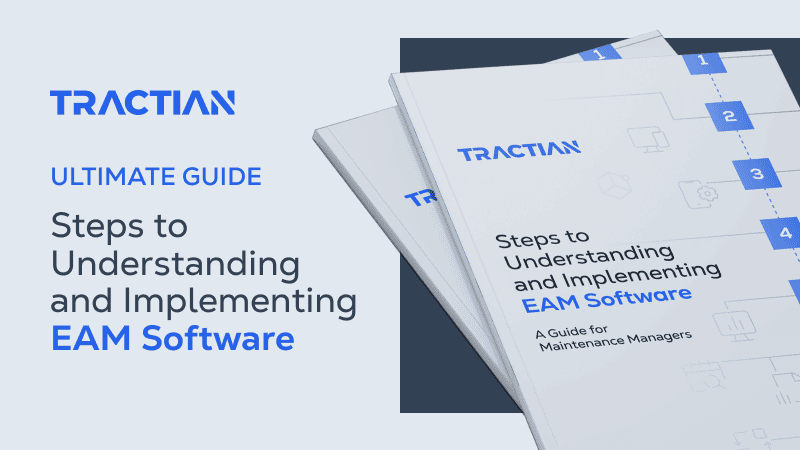Every maintenance manager knows the frustration of walking through a warehouse filled with parts that haven't moved in years. It's all too common to see valuable capital tied up in unused components, even as essential parts for daily operations remain unavailable due to backorders. And, depending on the situation, it may be a reflection of poor inventory management. Whatever the cause, it’s assuredly a systematic drain on your operation's financial health and efficiency.
The industry has a name for this type of inventory situation. It’s called "SLOB" inventory: slow-moving and obsolete parts that accumulate over time due to equipment changes, poor purchasing decisions, and a lack of systematic tracking.
In this guide, we'll walk you through the practical steps to calculate these percentages, identify parts heading toward obsolescence before they become a liability, and implement maintenance strategies that prevent future accumulation while maintaining the operational readiness your plant depends on.
What Are Slow-Moving Parts And Obsolete Inventory
Understanding the definition of slow-moving inventory begins with recognizing that these parts experience minimal usage or turnover over an extended period of time. Obsolete inventory takes this concept further, referring to parts with no expected future use, often due to equipment phase-outs or discontinued models.
Together, these categories form what the industry calls "SLOB" inventory (Slow-Moving and Obsolete), representing one of the most significant drains on maintenance budgets and operational efficiency. It’s vital to distinguish between these categories, as the difference will determine the best response strategy.
For instance, you could justify keeping a slow-moving bearing for a critical pump in stock despite low turnover. But an obsolete control module for equipment that was decommissioned last year represents pure waste. When you're asking, "What is slow-moving inventory?” think of specialized components like custom gaskets, rarely used sensors, or backup drives for older equipment that might move once or twice a year but remain necessary for operational continuity.
Obsolete inventory typically results from equipment upgrades, supplier discontinuations, or changes in production processes. Consider the pneumatic actuators sitting on your shelf after converting that line to electric drives, or the proprietary circuit boards for a control system that was replaced three years ago.
Why Slow-Moving And Obsolete Items Cause Operational Risks
The impact of SLOB inventory extends far beyond simple storage issues. A prime example comes from Plant Manager Sarah Chen, who reviewed her facility’s spare parts inventory and discovered that many items had not been used in years. She realized her team was essentially operating a very expensive parts museum instead of an efficient maintenance operation.
Scenarios just like this play out across industrial facilities where high SLOB percentages create cascading operational problems. Carrying excess slow-moving inventory ties up working capital that could be used to fund equipment upgrades, training programs, or process improvements. Every dollar locked in a dusty bearing that might never be used represents a dollar not available for initiatives that could actually improve plant performance.
Furthermore, warehouse space occupied by rarely-used parts creates inefficiencies that compound over time. Technicians waste valuable minutes searching through rows of obsolete components to find the parts they actually need, while prime storage locations get consumed by items that contribute nothing to daily operations.
The financial impact becomes particularly acute during inventory write-offs. When obsolete inventory finally gets recognized for what it is, the resulting balance sheet adjustments can significantly impact quarterly results and make it harder to justify future maintenance investments.
Here's how these risks manifest in daily operations:
- Cash Flow Constraints: Capital tied up in slow-moving inventory reduces available funds for critical maintenance activities, emergency repairs, and strategic improvements that could enhance overall equipment effectiveness.
- Storage Costs: Beyond the obvious space requirements, rarely used parts consume resources through climate control, security, inventory management labor, and the opportunity costs of premium storage locations.
- Maintenance Complexity: Excessive inventory makes finding needed parts more difficult, increases the likelihood of using wrong components, and creates confusion during emergency repairs when speed is critical.
- Financial Reporting: Obsolete inventory affects balance sheets through required provisions and write-offs, which impact financial ratios and may affect credit arrangements or investor confidence.
How To Calculate Slow-Moving Parts Percentages
Building on the operational risks we've identified, calculating your slow-moving parts percentage provides the quantitative foundation for addressing these issues systematically.
The slow-moving inventory calculation involves three distinct steps that transform raw inventory data into actionable insights about the effectiveness of your spare parts management.
Let’s break down how you can calculate Slow-Moving Parts Percentages:
1. Determine Inventory Value For Each Item
The first step in calculating slow-moving stock requires establishing the current value of each inventory item, which typically means using the original cost rather than attempting to estimate the current market value.
The basic formula is straightforward: Item Value = Unit Cost × Quantity on Hand.
However, complications arise with parts that have been in inventory for extended periods. Some organizations choose to apply depreciation schedules to older inventory, while others maintain original cost values until the items are officially written off.
For parts that are technically in inventory but unusable (what some facilities call "cat piece inventory not working"), you'll need to decide whether to include them at full value, partial value, or exclude them entirely from your calculations. The key is consistency across your entire inventory valuation process.
For example, imagine a hydraulic pump seal that was purchased a couple of years ago and is still sitting in inventory. If you originally purchased 8 units of a part at $150 each, the total value for this line item would be calculated as 8 times $150, based on the original purchase cost rather than any changes in current market price.
2. Set Time Thresholds For Slow Movement
Establishing appropriate time thresholds for slow-moving inventory analysis requires balancing operational realities with financial discipline. Most facilities use 12, 24, or 36-month periods, but the right choice depends on your equipment lifecycle, maintenance philosophy, and industry characteristics.
A 12-month threshold works well for facilities with predictable maintenance cycles and standardized equipment. However, plants with seasonal operations or equipment that requires major overhauls every few years might need longer thresholds to avoid misclassifying legitimately needed parts.
The challenge lies in distinguishing truly slow-moving items from those with cyclical or seasonal demand patterns. A part used only during annual shutdowns isn't slow-moving in the same way as a component that simply accumulated through poor purchasing decisions.
Critical spares present another consideration. A backup motor for your main production line might sit unused for years, but its presence prevents catastrophic downtime. These items require separate analysis despite meeting the technical definition of slow-moving stock.
3. Measure Percentage Against Total Stock
The actual calculation is simple: Slow-Moving Parts Percentage = (Value of Slow-Moving Parts ÷ Total Inventory Value) × 100. The proportion of slow-moving inventory considered healthy can vary widely depending on the industry sector and the maintenance strategy in place.
For example, if you have a total inventory value of $1,500,000 and identify parts that haven't moved in 24 months with a value of $225,000, you can calculate the slow-moving percentage by dividing the value of the slow-moving parts by the total inventory value and multiplying by 100. This sits at the upper end of the acceptable range and warrants investigation.
The same approach applies to calculating obsolete inventory percentages, typically using a longer time threshold and focusing on parts with no expected future demand. The combined SLOB percentage provides a comprehensive view of problematic inventory levels, helping to prioritize improvement efforts.

Proactive Ways To Manage And Reduce Slow-Moving Items
With identification methods established, the focus shifts to active management strategies that prevent the accumulation of slow-moving inventory while maintaining operational readiness. These approaches require balancing cost control with availability requirements, demanding both analytical rigor and practical judgment.
Segmentation And ABC Analysis
ABC analysis categorizes inventory items by value and usage frequency, with A items representing high-value, high-usage parts that deserve intensive management attention. For slow-moving items inventory management, this segmentation helps prioritize which items warrant continued stocking versus those that should be eliminated.
Apply ABC principles specifically to slow-moving inventory by creating subcategories within your slow movers and using an ABC Curve and Inventory Control resource. Category A slow movers might include expensive critical spares that justify carrying despite low turnover, while Category C slow movers could be inexpensive items that accumulated through poor purchasing decisions.
Different management approaches emerge from this segmentation. A-category slow movers might warrant supplier consignment arrangements or just-in-time delivery agreements, while C-category items could be candidates for immediate liquidation or disposal.
Adjust Reorder Points And Safety Stock
Recalculating appropriate reorder points for items with low usage prevents future accumulation of slow-moving inventory. The traditional reorder point formula (Lead Time × Average Usage + Safety Stock) requires modification when dealing with sporadic demand patterns.
For slow-moving items, consider using maximum usage rates rather than average usage to avoid understocking critical components. However, this must be balanced against the risk of creating more slow-moving inventory through excessive safety stock levels.
Safety stock calculations for slow-moving items should account for demand variability and supply uncertainty. The formula: Safety Stock = Z-score × √(Lead Time × Demand Variance) helps quantify appropriate buffer levels for moving inventory strategies.
Conduct Regular Cycle Audits
Focused audits of slow-moving inventory should be conducted quarterly or semi-annually, depending on the inventory value and turnover rates. These slow-moving inventory audits go beyond simple counts to evaluate condition, relevance, and future demand prospects.
The audit process should include a physical inspection for deterioration, verification of the continued applicability of equipment, and an assessment of alternative sourcing options. Items showing signs of degradation or obsolescence require immediate disposition decisions.
A systematic audit checklist may include: physical condition assessment, verification of equipment applicability, review of usage history, evaluation of alternative sourcing, and recommendation for disposition. This approach ensures consistent evaluation across all slow-moving items.
Connecting audit findings to disposition decisions creates a continuous improvement loop, where insights from previous audits inform future purchasing and stocking decisions, gradually reducing the accumulation of slow-moving inventory.
How A CMMS Streamlines Slow-Moving Parts Management
The manual processes described above become exponentially more effective when supported by a computerized maintenance management system that automates tracking, analysis, and decision-making processes. A CMMS transforms slow-moving parts management from a periodic exercise into a continuous optimization process.
Automatic flagging of items that haven't moved in specified timeframes eliminates the manual effort required to identify slow movers. The system continuously monitors usage patterns and alerts managers when parts cross predetermined thresholds for slow-moving status.
Inventory movement tracking and usage pattern analysis provide real-time visibility into consumption trends. Rather than waiting for quarterly reports, maintenance teams can see immediately when usage patterns change and take corrective action before items become obsolete.
Integrating maintenance schedules with inventory forecasting enables the prediction of future demand based on planned maintenance activities. This connection between maintenance planning and inventory management prevents both stockouts and overstock situations.
Key CMMS benefits for managing slow-moving inventory include:
- Automated Tracking: Systems continuously monitor part movement without manual intervention, flagging items that cross slow-moving thresholds and providing alerts to draw management attention.
- Usage Analysis: Consumption patterns are visualized through dashboards and reports that highlight trends, seasonal variations, and declining usage, which may indicate obsolescence.
- Forecasting: Predictive tools analyze historical usage patterns and planned maintenance schedules to forecast future demand, helping prevent accumulation of slow-moving inventory.
- Disposal Planning: Systems can suggest optimal timing for liquidation based on carrying costs, deterioration rates, and market conditions for surplus parts.
Sustainable Inventory Management
The journey from identifying slow-moving parts percentages to implementing systematic management practices represents a fundamental shift from reactive inventory control to proactive optimization. Maintaining healthy inventory levels requires ongoing attention to usage patterns, demand forecasting, and disposition decisions that strike a balance between operational needs and financial efficiency.
Proactive management prevents future accumulation by establishing systematic processes for purchasing decisions, usage tracking, and regular review cycles. Rather than allowing slow-moving inventory to accumulate gradually, effective systems catch potential problems early and provide mechanisms for corrective action, such as an action plan.
The balance between availability and efficiency remains the central challenge in spare parts management. The complete elimination of slow-moving inventory would reduce carrying costs, but it could expose operations to unacceptable downtime risks. Conversely, excessive safety stock provides operational security at the cost of capital efficiency.
Connecting inventory management to broader maintenance excellence creates synergies where improved planning reduces emergency purchases, better scheduling optimizes parts usage, and systematic analysis prevents both stockouts and overstock situations. This integrated approach transforms inventory from a necessary cost into a strategic asset that supports operational goals.
How Tractian CMMS Elevates Your Inventory Management
Managing slow-moving parts percentages effectively requires more than spreadsheets and periodic audits. You need a system that continuously monitors usage patterns, flags potential obsolescence, and provides the data needed for informed disposition decisions.
Tractian CMMS delivers exactly this capability through automated tracking and intelligent analysis that transforms inventory management from a reactive process into a proactive optimization strategy. The platform automatically identifies parts approaching slow-moving status based on configurable time thresholds and usage patterns, eliminating the manual effort required to track thousands of inventory items.
When combined with integrated maintenance scheduling, Tractian CMMS provides demand forecasting that prevents both stockouts and overstock situations by aligning inventory levels with planned maintenance activities. Real-time dashboards show inventory turnover rates, aging analysis, and obsolescence trends in formats that support immediate decision-making.
Rather than waiting for quarterly reports, maintenance teams can identify exactly which parts are trending toward obsolescence and take corrective action while options are still available. Tractian CMMS connects inventory optimization to broader maintenance excellence by linking parts usage to asset performance, maintenance schedules, and cost control initiatives.
Ready to transform your spare parts management from a cost center into a strategic advantage? Find out how Tractian CMMS helps you optimize inventory levels, reduce obsolescence, and maintain operational readiness without excess carrying costs.


